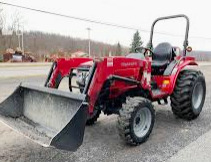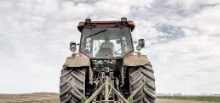________________________________________________________________________________________
| Home / Farm Tractors / Mahindra Tractors / Mahindra 1526 |
Mahindra 1526 Troubleshooting
 The
Mahindra 1526 is a 4WD 4x4 compact utility tractor. This model was manufactured
from 2016 to 2018. The Mahindra 1526 tractor is powered by 80.4 cu.in (1.32 L)
Mitsubishi S3L2 4-cycle 3-cylinder indirect injection diesel engine with a rated
power of 25.6 hp (19 kW). The Mahindra 1526 is fitted with a two transmission
options: synchro shuttle transmission with 8 forward and 8 reverse gears, or
3-range hydrostatic transmission with infinite forward and reverse gears.
The
Mahindra 1526 is a 4WD 4x4 compact utility tractor. This model was manufactured
from 2016 to 2018. The Mahindra 1526 tractor is powered by 80.4 cu.in (1.32 L)
Mitsubishi S3L2 4-cycle 3-cylinder indirect injection diesel engine with a rated
power of 25.6 hp (19 kW). The Mahindra 1526 is fitted with a two transmission
options: synchro shuttle transmission with 8 forward and 8 reverse gears, or
3-range hydrostatic transmission with infinite forward and reverse gears.
The maximum travel speed (forward/reverse): 11.7 mph (18.8 km/h) and 11.2 mph (17 km/h). The open center hydraulic system has a gear pump with a rated capacity of 7.5 gpm (28.5 lpm). The tractors are equipped with 7.00x16 (AG) or 25x8.5-14 (Turf) front tires and 11.2x24 (AG) or 13.6x16 (Turf) rear tires. The wheelbase is 67.3 inches (1700 mm). Compatible attachments for the tractor: Mahindra 1526L front end-loader with a maximum lift height at pivot pin of 84" (2130 mm), and Mahindra 1526B backhoe with a maximum digging depth of 86" (2180 mm).
| Diesel Engine Troubleshooting |
| Engine hard to start or doesn't start |
Air in the fuel lines - Bleed the fuel lines.
Fuel filter plugged - Clean the filter element.
Fuel injection nozzles are damaged or dirty - Clean or replace injection nozzles.
Water or dirt in fuel system - Drain, flush, and service the system.
The valve clearance is incorrect - Correct valve clearance needs to be set.
Damaged fuel injection pump - Replace or rebuild injection pump.
| Diesel starts and stalls immediately |
Restricted intake air - Carry out maintenance on air filter.
Fuel filter element is dirty - Clean the filter element.
Fuel injection pump is leaking - Repair any leaks.
Fuel injectors are faulty or clogged - Replace or clean fuel injectors.
Damaged fuel injection pump - Repair or replace injection pump.
| Engine stalls after running |
Engine not warmed up - Normalize the temperature by warming up the engine.
Fuel filter element is dirty - Clean or change the filter.
Air in fuel system - Bleed fuel system.
Fuel injection nozzles are faulty or clogged - Change fuel injection nozzles.
Fuel injection pump timing is wrong - Use the correct fuel injection pump timing adjustment.
| Engine stops when idling |
Incorrect low idle setting - Need to adjust idle speed.
Fuel injection pump is broken - Replace or rebuild injection pump.
Damaged or clogged injectors - Replace fuel injectors.
Valve clearance is wrong - Adjust valve clearance.
| Engine lacks power |
Plugged air filter - Change air filter element.
Clogged injection nozzle - Clean or change injection nozzles.
Fuel injection pressure is wrong - Adjust to correct pressure.
Valve clearance is not correct - Check and adjust.
Wrong adjustment of low idle speed - Adjust as required.
Fuel hoses or lines are dirty - Fuel hoses and lines must be clean.
Worn cylinder head gasket - Gasket should be replaced.
Worn or damaged piston rings - Install new piston rings.
| Engine overheats |
Engine coolant is insufficient - The cooling system needs to be refilled and checked for faults.
Lack of engine oil - Fill up the oil to required level.
Radiator core is clogged or radiator cap is leaking - Clean radiator or install new cap.
Fan belt is broken or worn - Belt change is required.
Engine is running overloaded - Reduce the load or use a lower gear.
| Oil pressure is insufficient |
Low crankcase oil level - Need to add oil.
Oil filter clogging - Replace or service engine oil filter.
Oil grade or viscosity is wrong - Use proper viscosity oil.
Crankshaft bearing has incorrect oil clearance - Change bearings.
Oil pump is defective - Remove and inspect oil pump.
| Engine knocking or noise |
Engine oil level low - Fill up the oil to required level.
Engine is cold - Warm up the engine.
Incorrect adjustment of fuel injection pump timing - Set it up as required.
Incorrectly adjusted low idle speed - Adjust low idling as recommended.
Clogged or defective injectors - Change or clean fuel injectors.
Connecting rod is defective or misaligned - Connecting rod needs to be replaced or aligned.
Worn or broken pistons - Pistons need to be replaced.
| Transmission Troubleshooting |
| Low transmission oil pressure |
Insufficient transmission oil - Fill the transmission housing with oil.
Transmission fluid filter element clogging (if equipped) - Replace or service transmission fluid filter.
Relief valve is damaged - Change the valve.
| Transmission makes excessive noise |
Lack of transmission oil supply - Add oil to the transmission housing.
Transmission fluid contamination - Transmission fluid change required.
Improper backlash or worn gears - Change the gears or set backlash properly.
Worn or damaged bearings - Install new bearings.
Worn or damaged gear shift forks - Change defective shift forks.
Shaft splines are worn or damaged - Shaft need to be changed.
| Gear shift is hard |
Gear shift linkage is corroded or worn - Install a new gear shift linkage.
Shift forks are bent or worn out - Shift forks need to be replaced.
Gearshift mechanism is damaged - Replace or repair the mechanism.
Improperly adjusted or worn clutch - Adjust clutch or replace if required.
| Transmission fluid leaks |
High transmission fluid level - Drain the excess fluid.
Seals or gaskets are broken - Install new components.
| Hydrostatic Transmission Troubleshooting |
| Excessive HST transmission noise |
Transmission oil is contaminated or oil level is insufficient - Fill to required level or change the transmission oil.
Speed control linkage is defective or unadjusted - Adjust or replace linkage.
Relief valve is stuck - Replace the valve.
Transmission overloaded - Reduce loading.
Transmission parts are worm or defective - Check internal transmission parts for damage or wear and replace if required.
| Loss of power |
Low oil level - Check transmission oil level and add oil as required.
Relief valve failure - Install a new valve.
Worn or unadjusted speed control linkage - Adjust or repair linkage.
| Transmission oil overheated |
Insufficient transmission oil - Need to add transmission oil.
Clogged transmission fluid filter - Replace or service transmission fluid filter.
Clogged or damaged cooling components - Check all cooling components and repair or change if required.
Transmission overload - The load should be reduced.
| Transmission oil leaks |
Seals or gaskets are broken - Install new gaskets or seal.
High internal transmission case pressure - Change defective parts.
Plugged transmission fluid return tube - Service or replace return tube.
| Hydraulics Troubleshooting |
| Hydraulic fluid pressure is low |
Insufficient hydraulic fluid - Fill up the hydraulic fluid.
Dirty hydraulic fluid filter - Hydraulic filter maintenance required.
Hydraulic pump is defective - Change or repair hydraulic oil pump.
Incorrect adjusted hydraulic control valve - Adjust correctly.
Hydraulic cylinder not working - Repair or change hydraulic cylinder.
Leaks in hydraulic pipes - Inspect hydraulic system for leaks and repair it.
| Hydraulic system overheating |
Defective main relief valve - Replace relief valve.
Incorrect type of hydraulic oil - The correct type of oil must be used.
Hydraulic oil is dirty - Hydraulic oil change required.
Air in hydraulic lines - Bleed hydraulic lines.
| Hitch won't raise or raises slowly |
Excessive loading on the hitch - Load needs to be reduced.
Low hydraulic fluid level - Fill up the hydraulic fluid.
Dirty hydraulic oil filter element - Clean the hydraulic filter element or replace if necessary.
Defective hydraulic pump - Change or repair hydraulic fluid pump.
Defective main relief valve - Relief valve replacement required.
Defective hydraulic control valve block - Replace or repair the valve.
Faulty hydraulic cylinder - Repair or install a new hydraulic cylinder.
Disconnected or broken suction line - Change or connect properly.
| Hitch cannot be lowered or lowering is too slowly |
Hydraulic control valve is set improperly - The control valve must be set correctly.
Hydraulic cylinder failure - Replace or repair hydraulic cylinder.
The hitch has not been adjusted - Adjust three-point hitch as required.
Damaged lift arm shaft - Replace the shaft.
| Hitch lower or lift is jerky |
Air in the hydraulic system - Air bleeding.
Hydraulic oil is contaminated - Fill up with fresh hydraulic oil.
Damaged hydraulic pump - Install a new hydraulic oil pump.
Hydraulic spool valve block is faulty - Install a new valve or repair it.
Hydraulic cylinder malfunction - Repair or change hydraulic cylinder.
| Steering Troubleshooting |
| Steering is hard |
Incorrectly fitted or worn steering column - Refit or replace the steering column.
Air trapped inside steering system - Need to bleed air.
Improper toe-in - Adjust toe-in wheels.
Uneven tire pressure - Inflate the tires properly.
Defective hydraulic steering pump - Steering pump needs to be repaired or replaced.
Faulty or stuck pump flow control valve - Clean or replace control valve.
Steering oil level is insufficient - Checking steering oil level and add it if necessary.
| Excessive play in steering |
Steering column shaft or coupling has maximum wear - Replace defective part.
Defective hydraulic steering pump - Install a new steering pump.
Steering linkage parts are loose or worn - Inspect and replace as required.
| Tractor pulls to left or right |
Uneven tyre pressure - Inflate the tyres properly.
Incorrect toe-in - Adjust toe-in properly.
Loose or worn steering linkage parts - Check and change as required.
Improperly adjusted or defective front wheel bearings - Adjust correctly or change bearings.
| Electrical Troubleshooting |
| Battery cannot be charged |
Corroded or loose wire connections - Clean or tighten wiring connections.
Defective battery terminal clamps - Install new terminal clamps.
Battery is defective - Battery change required.
Loose or worn belt - Need to adjust belt tension or replace belt.
| Starter cranks slowly |
Low battery capacity - Recharge the battery.
Battery drains quickly - Battery needs service or replacement.
Bad battery terminals or disconnected wiring - Connect wires properly or change terminals.
| Starter is not cranking |
Battery is discharged or defective - Recharge or replace battery.
Wire harness is disconnected or incorrectly connected - Check wire harness and connect as required.
Low battery power - Battery needs to be recharged.
Starter motor failing - Change or repair starter.
________________________________________________________________________________________
________________________________________________________________________________________
| Farm Tractors Technical Specifications |
